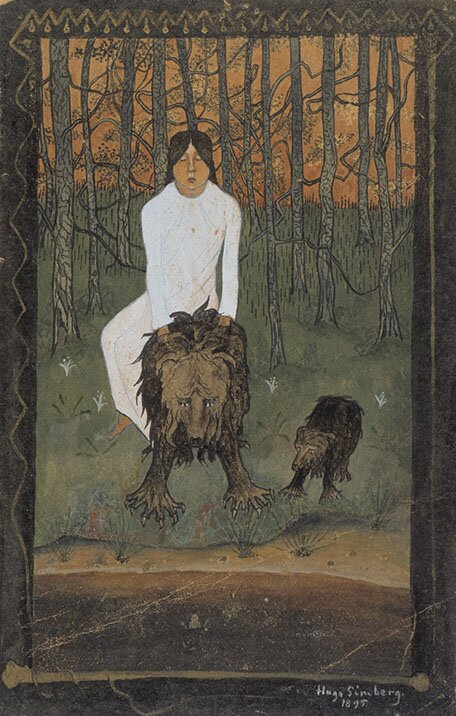
The Fairy-Tale I, 1895
A II 968:4
Ateneum
The Fairy-Tale I
The early 1890s was a time of change in fine art. A new style, Symbolism, emerged to complement art that sought to depict the visible world. According to symbolist philosophy, there is within our everyday experience another, more important, inner reality, which can be made alive and radiant by a symbol – a picture or a poem, for instance.
These new winds in art did not make themselves felt in the Ateneum, where Hugo Simberg studied. Instruction was traditional and academic. Students spent much of the time drawing from plaster casts. The idea began developing in Simberg’s mind of a different way to study. He picked up his courage and wrote to Axel Gallén*, who was building a ‘wilderness studio’ in Ruovesi, and asked to be accepted as a private student. The master’s positive reply signalled the beginning of a new, important phase in Simberg’s artistic career.
* from 1907 Akseli Gallen-Kallela
For Simberg the Ruovesi period was a time of discovering his creativity. With the bustle and responsibilities of city life behind him, he suddenly came face to face with the Finnish wilderness and a darkening autumn. This was an opportunity to wind down – and paint just as he wanted. Already during the first autumn, Simberg painted some of his key works: Frost and The Fairy-Tale I. This was the first time that the powerful effect of nature, Simberg’s fantasy world and artistic goals all converged into a completely unique form.

Frost, 1895
A II 968:3
Ateneum

“I think a work of art is a work that speaks to me of another world and arouses in me the feeling that the artist wants to convey. It must lead my thoughts to something we do not think about every day, and I must see the image in my mind and think about it afterwards for a long, long time. It is quite obvious that that can be achieved by good naturalism, but it is even more obvious that it can be achieved easier through stylisation.”
– Hugo Simberg in a letter to his twin brother, Paul Simberg, on 2 February 1896. Hugo Simberg Archive, Finnish National Gallery.

Gallen-Kallela Skiing, 1897
C IV 1553
Ateneum
Gallen-Kallela and Simberg got along well. The master introduced his student to new methods that were not yet known in Finland. The most important of these for Simberg proved to be printmaking techniques. Indeed, Hugo Simberg became one of the pioneers of Finnish fine art printmaking, along with Akseli Gallen-Kallela.
“I have a student here, Simberg, who is quite exceptionally talented. His art will be of great importance if he progresses along the path he has already embarked upon. An extraordinary talent, quite in the style of 14th and 15th century masters […] His works are like sermons that everybody must listen to and that embed themselves in the mind. This is because they are made with such truthfulness and emotional intensity.”
– Akseli Gallen-Kallela in a letter to Louis Sparre, 10 December 1895. Collection of artists’ letters, Finnish National Gallery.
Read more
The Fairy-Tale I in our online Art Collections
Studies in Ruovesi under Gallen-Kallela
The autumn theme
Graphic art by Hugo Simberg